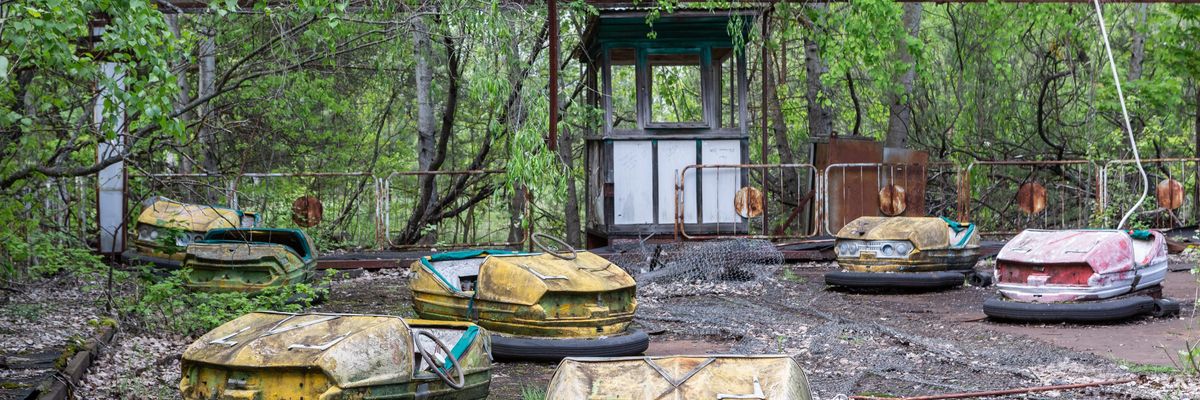
Abandoned bumper cars full of rust sit in an amusement park in the ghost city of Pripyat, Ukraine, which was evacuated on the afternoon of April 27, 1986, 36 hours after the Chernobyl Nuclear Power Plant disaster. (Photo: Francisco Goncalves/Getty Images)
Chernobyl Redux?
Russia's attack on Ukraine could release nuclear fallout across the globe.
Hiding in plain sight amidst the chaos of a possible war in Ukraine is the horrifying potential of another Chernobyl-scale apocalypse.
As home to Chernobyl, the world's deadliest atomic reactor disaster, Ukraine depends for more than half of its electricity on fifteen nuclear reactors. All but two were built by the Soviet Union. Until now, they've been mostly serviced and fueled by Russia.
Because it is so heavily laden with poorly stored, highly radioactive material, any military assault would be fraught with horrific potential fallout.
A dozen of those reactors are more than thirty years old, having gone on line while the Soviet Union still ruled the region. The six in the Ukrainian city of Zaporozhye are within easy striking distance of the "People's Republics" of Donetsk and Luhansk now being independently recognized by Russian president Vladimir Putin.
Like all "Peaceful Atom" reactors, Ukraine's are effectively pre-deployed weapons of a mass apocalypse. Chernobyl's April 26, 1986, meltdown and explosion spread radiation throughout the planet, and it blanketed much of Ukraine and Belarus with deadly radiation that penetrated throughout Europe and was detected in alarming quantities as far away as North America.
According to Chernobyl: Consequences of the Catastrophe for People and the Environment, published in 2007 by Alexey Yablokov and others, the disaster's radioactive fallout had by then killed more than 985,000 people worldwide, with tens of thousands more casualties likely since then.
Three other dead reactors still sit at the Chernobyl site. Because it is so heavily laden with poorly stored, highly radioactive material, any military assault would be fraught with horrific potential fallout. But even more vulnerable are Ukraine's six reactors at Zaporozhye and nine more operating at three other sites further west.
Any military action, whether targeted or accidental, could affect the control mechanisms, backup power, spent fuel pools, or emergency cooling systems and potentially yield another Chernobyl-level catastrophe with unspeakable health, ecological, and financial impacts. A cyberattack on Ukraine's power grid could have consequences on the safety and operating systems of these plants. An interruption of the water supply could affect the ability of the plants to function as well.
The region immediately surrounding Chernobyl still seethes with radiation from a disaster that occurred more than thirty-five years ago: An entire town of 50,000 people--Pripyat--remains abandoned, far too radioactive for safe human habitation.
Like that of Chernobyl, the radiation from any of Ukraine's currently operating reactors could utterly level the country politically and financially. Former Prime Minister Mikhail Gorbachev lists Chernobyl as the number one factor that fed the collapse of the Soviet Union.
Thus far, there's been no explicit mention of Ukraine's nuclear reactors in Putin's saber-rattling, but Russia's role in maintaining and fueling Ukraine's currently operating reactors hangs like a sword over the country's power supply.
Like most nuclear reactors still operating on this planet (including the ninety-three in the United States) Ukraine's are old and shaky. Even unrelated military chaos could threaten their orderly operation and lead to catastrophe.
Worse for the world as a whole, Putin has the power at the tip of his fingers--even with a relatively small, easy military strike--to carpet that entire region for a second time with enormous quantities of radiation, while sending a lethal cloud throughout the Earth's biosphere.
For the Peaceful Atom, the ultimate curse may be at the brink of coming home to roost.
An Urgent Message From Our Co-Founder
Dear Common Dreams reader, The U.S. is on a fast track to authoritarianism like nothing I've ever seen. Meanwhile, corporate news outlets are utterly capitulating to Trump, twisting their coverage to avoid drawing his ire while lining up to stuff cash in his pockets. That's why I believe that Common Dreams is doing the best and most consequential reporting that we've ever done. Our small but mighty team is a progressive reporting powerhouse, covering the news every day that the corporate media never will. Our mission has always been simple: To inform. To inspire. And to ignite change for the common good. Now here's the key piece that I want all our readers to understand: None of this would be possible without your financial support. That's not just some fundraising cliche. It's the absolute and literal truth. We don't accept corporate advertising and never will. We don't have a paywall because we don't think people should be blocked from critical news based on their ability to pay. Everything we do is funded by the donations of readers like you. Will you donate now to help power the nonprofit, independent reporting of Common Dreams? Thank you for being a vital member of our community. Together, we can keep independent journalism alive when it’s needed most. - Craig Brown, Co-founder |
Hiding in plain sight amidst the chaos of a possible war in Ukraine is the horrifying potential of another Chernobyl-scale apocalypse.
As home to Chernobyl, the world's deadliest atomic reactor disaster, Ukraine depends for more than half of its electricity on fifteen nuclear reactors. All but two were built by the Soviet Union. Until now, they've been mostly serviced and fueled by Russia.
Because it is so heavily laden with poorly stored, highly radioactive material, any military assault would be fraught with horrific potential fallout.
A dozen of those reactors are more than thirty years old, having gone on line while the Soviet Union still ruled the region. The six in the Ukrainian city of Zaporozhye are within easy striking distance of the "People's Republics" of Donetsk and Luhansk now being independently recognized by Russian president Vladimir Putin.
Like all "Peaceful Atom" reactors, Ukraine's are effectively pre-deployed weapons of a mass apocalypse. Chernobyl's April 26, 1986, meltdown and explosion spread radiation throughout the planet, and it blanketed much of Ukraine and Belarus with deadly radiation that penetrated throughout Europe and was detected in alarming quantities as far away as North America.
According to Chernobyl: Consequences of the Catastrophe for People and the Environment, published in 2007 by Alexey Yablokov and others, the disaster's radioactive fallout had by then killed more than 985,000 people worldwide, with tens of thousands more casualties likely since then.
Three other dead reactors still sit at the Chernobyl site. Because it is so heavily laden with poorly stored, highly radioactive material, any military assault would be fraught with horrific potential fallout. But even more vulnerable are Ukraine's six reactors at Zaporozhye and nine more operating at three other sites further west.
Any military action, whether targeted or accidental, could affect the control mechanisms, backup power, spent fuel pools, or emergency cooling systems and potentially yield another Chernobyl-level catastrophe with unspeakable health, ecological, and financial impacts. A cyberattack on Ukraine's power grid could have consequences on the safety and operating systems of these plants. An interruption of the water supply could affect the ability of the plants to function as well.
The region immediately surrounding Chernobyl still seethes with radiation from a disaster that occurred more than thirty-five years ago: An entire town of 50,000 people--Pripyat--remains abandoned, far too radioactive for safe human habitation.
Like that of Chernobyl, the radiation from any of Ukraine's currently operating reactors could utterly level the country politically and financially. Former Prime Minister Mikhail Gorbachev lists Chernobyl as the number one factor that fed the collapse of the Soviet Union.
Thus far, there's been no explicit mention of Ukraine's nuclear reactors in Putin's saber-rattling, but Russia's role in maintaining and fueling Ukraine's currently operating reactors hangs like a sword over the country's power supply.
Like most nuclear reactors still operating on this planet (including the ninety-three in the United States) Ukraine's are old and shaky. Even unrelated military chaos could threaten their orderly operation and lead to catastrophe.
Worse for the world as a whole, Putin has the power at the tip of his fingers--even with a relatively small, easy military strike--to carpet that entire region for a second time with enormous quantities of radiation, while sending a lethal cloud throughout the Earth's biosphere.
For the Peaceful Atom, the ultimate curse may be at the brink of coming home to roost.
Hiding in plain sight amidst the chaos of a possible war in Ukraine is the horrifying potential of another Chernobyl-scale apocalypse.
As home to Chernobyl, the world's deadliest atomic reactor disaster, Ukraine depends for more than half of its electricity on fifteen nuclear reactors. All but two were built by the Soviet Union. Until now, they've been mostly serviced and fueled by Russia.
Because it is so heavily laden with poorly stored, highly radioactive material, any military assault would be fraught with horrific potential fallout.
A dozen of those reactors are more than thirty years old, having gone on line while the Soviet Union still ruled the region. The six in the Ukrainian city of Zaporozhye are within easy striking distance of the "People's Republics" of Donetsk and Luhansk now being independently recognized by Russian president Vladimir Putin.
Like all "Peaceful Atom" reactors, Ukraine's are effectively pre-deployed weapons of a mass apocalypse. Chernobyl's April 26, 1986, meltdown and explosion spread radiation throughout the planet, and it blanketed much of Ukraine and Belarus with deadly radiation that penetrated throughout Europe and was detected in alarming quantities as far away as North America.
According to Chernobyl: Consequences of the Catastrophe for People and the Environment, published in 2007 by Alexey Yablokov and others, the disaster's radioactive fallout had by then killed more than 985,000 people worldwide, with tens of thousands more casualties likely since then.
Three other dead reactors still sit at the Chernobyl site. Because it is so heavily laden with poorly stored, highly radioactive material, any military assault would be fraught with horrific potential fallout. But even more vulnerable are Ukraine's six reactors at Zaporozhye and nine more operating at three other sites further west.
Any military action, whether targeted or accidental, could affect the control mechanisms, backup power, spent fuel pools, or emergency cooling systems and potentially yield another Chernobyl-level catastrophe with unspeakable health, ecological, and financial impacts. A cyberattack on Ukraine's power grid could have consequences on the safety and operating systems of these plants. An interruption of the water supply could affect the ability of the plants to function as well.
The region immediately surrounding Chernobyl still seethes with radiation from a disaster that occurred more than thirty-five years ago: An entire town of 50,000 people--Pripyat--remains abandoned, far too radioactive for safe human habitation.
Like that of Chernobyl, the radiation from any of Ukraine's currently operating reactors could utterly level the country politically and financially. Former Prime Minister Mikhail Gorbachev lists Chernobyl as the number one factor that fed the collapse of the Soviet Union.
Thus far, there's been no explicit mention of Ukraine's nuclear reactors in Putin's saber-rattling, but Russia's role in maintaining and fueling Ukraine's currently operating reactors hangs like a sword over the country's power supply.
Like most nuclear reactors still operating on this planet (including the ninety-three in the United States) Ukraine's are old and shaky. Even unrelated military chaos could threaten their orderly operation and lead to catastrophe.
Worse for the world as a whole, Putin has the power at the tip of his fingers--even with a relatively small, easy military strike--to carpet that entire region for a second time with enormous quantities of radiation, while sending a lethal cloud throughout the Earth's biosphere.
For the Peaceful Atom, the ultimate curse may be at the brink of coming home to roost.

